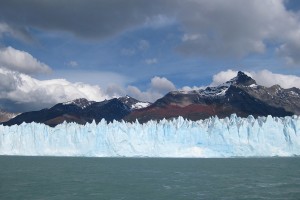The Hows and Whys of Glaciers
If you have ever been fortunate enough to see a glacier up close, it is hard not to be struck by the sheer scale of this huge ice formation. How can something so enormous have formed, and how is it possible for these huge structures to move? There are numerous examples world wide of the effect that glaciers can have on the landscape as they move, grow and retract, carving new shapes out of solid rock. But how can ice alone be responsible for such dramatic changes?
Glaciers form in areas where snowfall exceeds melting, and so snow is present on the ground year-round. As new snow falls it covers and compresses previous layers, transforming snow into ice; the weight of new snow causes older layers to re-crystalise. Over time these ice crystals grow larger, and in ancient glaciers the crystals can grow to several inches in length. Freshly created glacial ice is white, but as it becomes more compact over time it takes on a deep blue tinge. It is the high density and extreme weight of glacial ice which is responsible for its extreme terrain-shaping capabilities.
Glacial movement is caused by the sheer weight of the glacial ice, which causes stress on the ice sheet. Glaciers usually form into an accumulation area, where snowfall is high, and an ablation area, where most melting and evaporation occurs. When these two processes are in equilibrium, the glacier is balanced. Changes in snowfall or melting will cause the glacier to either advance or retreat, which is why glaciers are so vulnerable to climatic changes. But exactly how is solid ice capable of ‘flow’ similar to liquid water? The answer to this comes from a quirk in the chemistry of water. For most substances, as pressure increases, melting point decreases, causing them to become more stable. This is not the case for ice; the melting point of water decreases as pressure increases. The high pressures exerted on ice at the base of a glacier, combined with heat released from the earth itself causes this ice to melt. Small quantities of liquid water at the base of the glacier allow it to slide over the land.

Glacial movement causes the development of huge crevasses in the ice sheet, as well as grinding up rock and soil underneath the glacier. Debris can be carried huge distances by the movement of the glacier. Dark bands of debris in the ice, known as moraines, are evidence of this transport. While glacial movement typically occurs slowly, over periods of hundreds or thousands of years, in some cases movement can be much faster. The Kutiah glacier in Pakistan holds the record for the fastest recorded glacial movement, advancing 12km in just 3 months during one glacial surge!
At present, around 10% of land area (15,000,000 km2) on Earth is covered by glacial ice, containing about 75% of the world’s fresh water. Almost all of this ice is contained within huge ice sheets in the polar regions, however glaciers are found on every continent except Australia. The ice sheets in the polar regions are particularly ancient, and the antarctic ice sheet has persisted for at least 40 million years.
As well as shaping landscapes, glaciers have a significant impact on human populations. Annual glacial melt is a significant source of fresh water for people (as well as plants and animals) in extremely harsh environments, and provides fresh water for around one third of the worlds population.
Want to Know More?


